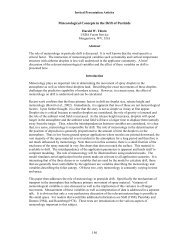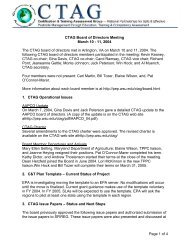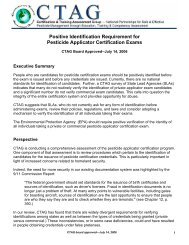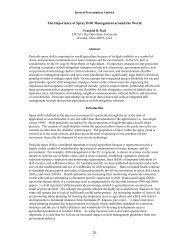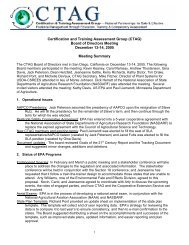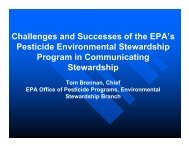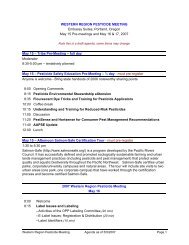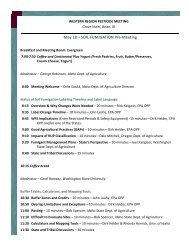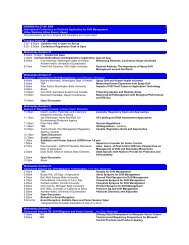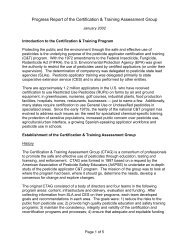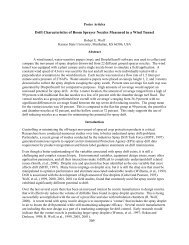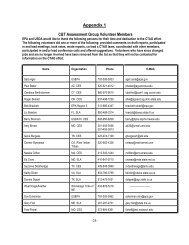Fumitoxin Labels - WSU Pesticide Safety Education Program
Fumitoxin Labels - WSU Pesticide Safety Education Program
Fumitoxin Labels - WSU Pesticide Safety Education Program
- No tags were found...
You also want an ePaper? Increase the reach of your titles
YUMPU automatically turns print PDFs into web optimized ePapers that Google loves.
Background• Aluminum Phosphide and Magnesium Phosphide,some of the common trade names:– <strong>Fumitoxin</strong>– Phostoxin– Fumex,– Gastoxin– Phosfume– Fumiphos
Aluminum PhosphideProperties• Formulated in pellets, granules, or as a dust• Upon contact with moisture in theenvironment, aluminum phosphide undergoesa chemical reaction yielding phosphine gas• Heavier than air• Rapidly acting fumigant that does not leaveresidues on the stored product• Warning agents have the odor of decaying fishor garlic at concentrations below 0.3 ppm
Aluminum Phosphide Uses– Stored Commodity Treatments• Raw Agricultural Commodities (nuts, seeds, etc)• Processed Foods (sugar, flour, cereals, coffee, etc)• Non‐food Commodities (furniture, wood, cotton,etc)– Burrowing Rodent Control• Prairie dogs• Woodchucks, Yellowbelly marmots (rockchucks)• Norway rats, roof rats, mice• Ground squirrels, moles, voles• pocket gophers and chipmunks.
Changes• February 2010 –– Utah misuse case –2 deaths– Extermination company applies the productwithin ihi 15 ft of home, in violation i of lbl labelrequirements.• EPA reacts with label changes– States t are not included din these discussionsi– 100 ft buffers imposed– Intent is to ensure product can no longer be usedaround residential structures
40 CFR 152.3 Definitions• Residential Use means use of a pesticidedirectly:1) On humans or pets2) In, on, or around any structure, vehicle, article,surface, or area associated with the household,including but not limited to areas such as non‐agricultural outbuildings, non‐commercialgreenhouses, pleasure boats and recreationalvehicles, or3) In any preschool or day care facility
EPA’s Label Changes• Front Cover of the label states:“THE USE OF THIS PRODUCT IS STRICTLY PROHIBITEDON SINGLE AND MULTI‐FAMILY RESIDENTIALPROPERTIES AND NURSING HOMES, SCHOOLS(EXCEPT ATHLETIC FIELDS), DAYCARE FACILITIES ANDHOSPITALS. ”• This prohibition was intended for burrowingThis prohibition was intended for burrowingrodent control applications. CDA feels thatmaking this statement on the front cover extendsthe prohibition to all uses and sites listed in thelabel.
EPA’s Label Changes• This statement continues throughout thelabel.– Product Information section:• In this section the prohibition of use on“properties” is stated separately from theburrowing vertebrate reference.• Reinforces that the prohibition applies to morethan just burrowing rodent applications.– Stored Commodities section
EPA’s Label Changes– Burrowing Rodent Section• 100 ft buffers from buildings “that is, or maybe, occupied by humans, and/or domesticanimals.”• “…for use ONLY on agricultural areas, orchards,f g , ,non‐crop areas (such as pasture andrangeland),” etc…
EPA’s Label Changes• “…in athletic fields or parks, the applicator shallpost a sign at entrances…”• “…product is used out‐of‐doors to a site otherthan an athletic field or park, the applicatorshall post a sign at the application site…”• “Document any burrows that open under orinto occupied buildings…”
EPA’s Label Changes• “For use by a certified applicator or personunder their direct supervision and who havebeen trained specifically for use of this productin burrowing pest control.”• “Pack the treated entrance with crumpledpaper and shovel soil to completely cover thepaper.”
EPA’s Label Changes• Training requirements above and beyondcertification• FMPs• Supervision
Why a Problem?• Stored commodity treatments on privateproperty– Farm Bins• Flat Storages• Vertical Storage– Containers, trucks, vans, and other vehicles– Tarpaulin and bunker fumigations– Small sealable enclosures– Beehives and beekeeping equipment– Rodent burrows – not within 100 ft
Why a Problem?• The restrictions in the burrowing rodentsection do several things.– Residential zoned properties, regardless of howmany acres• Site restrictions “For use ONLY on…” statements.• Applications can no longer be made to a “property”with a single/multi‐family residence. (Would includeagriculture properties with a single family residence.)• Prohibits applications within 100 feet of ANY structure(barn, storage sheds, etc.)
5 + acre property w/single familyhome – Aluminum PhosphideOpen100 ftShedShed25ftSpace/Rangeland100 ftResidentialstructure50 ft100 ft
EPA Label – Cont.• Areas zoned residential/agriculture or agriculture,the label does not allow applications when thereis a single family residence on the “property”.• A farmer’s residence on the property wouldmeet the definition of “Residential” in 40 CFR,“…In, on, or around any structure, vehicle, article,surface, or area associated with the household…”• 40 CFR does not distinguish single familyresidences on agricultural lproperties anydifferent than urban residences
Open5 + acre Ag property w/single familyhome – Aluminum Phosphidesilo ShedShedSpace/RangelandResidentialstructure50 ft100 ft
CDA Concerns• Aluminum Phosphide widely used in Coloradofor:– Burrowing rodent control• Prairie dogs• Marmot / Woodchuck• Ground squirrels– Stored commodity / non‐food item treatments– Stored commodity / non‐food item treatments• Grain bins• Trailer fumigation• Rail cars
CDA Concerns• 10/22/2010, in Broomfield, Colorado, after aprairie dog colony died off, Tularemia wasdiagnosed within the colony.• County health officials began investigating thedie‐off on Oct. 5, and cordoned off an areasouth and west of Uptown Avenue in theArista development to limit access of peopleand their pets.• Animals can be infected by eating dead ordying carcasses.
CDA Concerns• Colorado Department of Public Health andEnvironment, since 1993 an average of onehuman case of plague, two to three humancases of tularemia, and four human cases ofhanta virus are reported each year. Localenvironmental health officials respond toplague positive prairie dog colonies each year,with the intensity and geographic areasaffected varying from year to year.
CDA Concerns• Residential / Residential Ag / Non‐crop nearurban areas and properties– No other alternative products available in someinstances– Efficacy and safety of applying alternativeproducts is a concern– Label restrictions of alternative products
CDA Concerns – Alternative Products• Rozol Prairie Dog Bait– Use site ‐ Rangeland and non‐crop only– October 1 – March 15 use restrictions– Bait applied to the surface• Applications made near urban areas, in open spaceareas raise the concern for domestic animal and publiccontact• Domestic animal secondary poisoning concerns
Rozol Prairie Dog BaitOpenShedShedSpace/Rangelandc non‐crop?? = no use Oct – March 15Residentialstructure50 ft100 ft2 ft
CDA Concerns – Alternative ProductsZP Ag Bait ‐ For prairie dog use– Use prohibited “near” residential properties– Areas of application within 100 ft of a residencemay be label violation depending on how the SLAdetermines what is considered “near”
Bait Products –ZP AgOpenShedShedSpace/RaNEAR???ResidentialstructureNEAR???ngeland50 ft100 ft
ZP Ag Bait– Can only be applied from July – December–No bait products on the market from March 15 –July 1 that could be used for prairie dog control–Can only make one application during this period–Must be applied to the surface of the mound–Poor efficacy = potential for misuse–Non‐target exposure / secondary poisoningconcerns to domestic animals and public
ZP Ag ApplicationsOpenShedShedSpace/Rangelandc near = no use July ‐ DecemberResidentialstructure50 ft100 ft25 ftREMEMBER…only1 applicationduring this period.
Prairie Dog hole
Bike TrailDead Prairie Dog
CDA Concerns – Alternative Products• Pressurized Exhaust Rodent Controller (PERC): “Aninternal combustion engine is used to both generatecarbon monoxide and pressurize it to 110 PSI. Usingmultiple probes, burrows are easily detected andquickly filled with a lethal concentration of carbonmonoxide”– This device does not require licensure at this time to use =no training required• Currently CDA has no devices in Rule that require licensure to use• CDA may have no authority over private persons misusing a device• CDA may have no authority over a commercial applicator usingdevices that do not require licensure– Directions warn operator to not use within 150 feet of astructure
PERC
Underground Exterminator Rodent Killer$16.99In Stock - EstimateDelivery Dateloading ...Immediate results using pressurized carexhaust induces unconsciousness, whichgoes to the rodents, who must breathe,killing them painlessly, in 15 to 30 minutes.Adapter connects exhaust pipe to gardenhose and into lawn or ground outside home.Kills moles, gophers, voles, rats, mice,chipmunks, woodchucks, ground squirrels,groundhogs, prairie dogs, armadillos,skunks, snakes and muskrats. Effectivecontrol on all rodents up to 275', killingmore than one at a time. No need to disposeof dead animals. No poison to harm childrenor pets. This Underground d ExterminatortRodent Killer is one of many top qualityitems in our Mouse & Rat Poisondepartment
CDA Concerns – Alternative Products• Rodenator
March 15 –July 1 ?What products are available?ShedShedPressurized Exhaust RodentController (PERC). – 150 ftResidentialstructure50 fthttp://www.youtube.com/watch?v=1AdCsJmU‐PA&feature=player_detailpage100 ft40 acre property w/single family home –PERC or Rodenator
CDA Concerns – Alternative Products• USDA Gas Cartridges– Release Carbon Monoxide– Poor efficacy– Fire danger– Few restrictions, titi no license required dto use = notraining– No restrictions on distance to a structure
OpenMarch 15 –July 1 ?What products are available?ShedShedSpace/RangelandResidentialstructure50 ft100 ft25 ftNo distance restrictionsi40 acre property w/single family home –USDA Gas Cartridges
Not Labeled for Prairie Dogs
CDA Concerns• Homemade products –– Illegal l or unsafe uses of rodenticidesid– Homebrew rodenticides• No treatments = increased rodent pressure
CDA Label Amendment Request• FOR BURROWING RODENT APPLICATIONS THEFOR BURROWING RODENT APPLICATIONS THEUSE OF THIS PRODUCT IS STRICTLY PROHIBITEDWITHIN 100 FEET OF ANY BUILDING WHEREHUMANS AND/OR DOMESTIC ANIMALS DO ORMAY RESIDE ON SINGLE AND MULTI‐FAMILYRESIDENTIAL PROPERTIES AND NURSING HOMES,SCHOOLS (EXCEPT ATHLETIC FIELDS), DAYCAREFACILITIES AND HOSPITALS.
CDA Label Amendment RequestCDA feels the addition of a less restrictiveprovision, as stated below, should be allowedfor structures that are not used for habitation.FOR ALL OTHER STRUCTURES THAT ARE LOCATED INEXCESS OF 100 FEET FROM THE BUILDINGS LISTEDABOVE, INCLUDING TOOL SHEDS, STORAGE SHEDS ORSIMILAR UNINHABITED STRUCTURES, DO NOT APPLYTHIS PRODUCT TO A RODENT BURROW SYSTEM WITHIN25 FEET OF THESE STRUCTURES.
OpenSpace/Rangeland40 acre property w/single familyhome – Proposed Phosphide UseShedResidentialstructure50 ft100 ftShed25 ft
EPA HQMarty MonellDeputy Office DirectorOffice of <strong>Pesticide</strong> <strong>Program</strong>sMail Code 7501PU.S. Environmental Protection Agency1200 Pennsylvania Avenue NWWashington, DC 20460monell.marty@epa.govMeredith Laws, Chief 7505PProduct Manager 7Insecticide‐Rodenticide BranchRegistration DivisionOffice of <strong>Pesticide</strong> <strong>Program</strong>s1200 Pennsylvania Avenue NWWashington, DC 20460Laws.Meredith@epamail.epa.gov
John Scott<strong>Pesticide</strong>s <strong>Program</strong> ManagerColorado Department of Agriculture700 Kipling St, Suite 4000Lakewood, CO 80215303‐239‐4179John.Scott@ag.state.co.us



